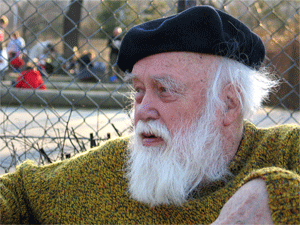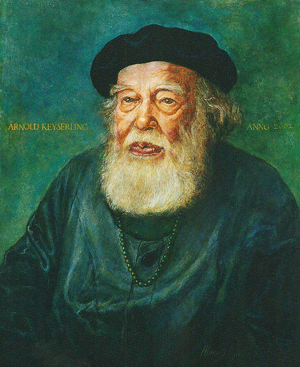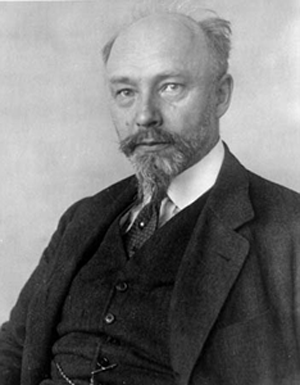Re: School of Wisdom, by SourceWatch
Arnold Keyserling
by Wikipedia
Accessed: 10/1/18
NOTICE: THIS WORK MAY BE PROTECTED BY COPYRIGHT
Arnold Keyserling ( Arnold Alexander Herbert Otto Heinrich Constantin Graf Keyserling [1], born February 9, 1922 in Friedrichsruh , † September 7, 2005 in Matrei am Brenner ) was a German-Austrian philosopher and religious scholar.
Life

Arnold Keyserling, in Stadtpark Wien (March 2005)

Portrait Arnold Keyserling by Mimi Staneva, Vienna 2002
Arnold Keyserling was the son of the philosopher and writer Hermann Graf Keyserling and a great-grandson Otto von Bismarck. At the institute of his father, the "School of Wisdom" in Darmstadt, famous thinkers and poets such as Carl Gustav Jung, Richard Wilhelm, Herman Hesse, Oscar AH Schmitz and Rabindranath Tagore frequented in the 1920s. Thus, the young Keyserling early benefited from a comprehensive humanistic education. When the National Socialists took power, the family was ostracized as an anti-state and the "School of Wisdom" was forcibly closed. 1939, after the Anschluss of Austria Arnold Keyserling, who then studied law at the University of Vienna, was expelled from the university.
After the war Arnold Keyserling met in Alpbach Wilhelmine von Auersperg (born June 18, 1921), whom he married after five years of engagement. Together, they traveled extensively, sometimes on motorcycles.
Arnold Keyserling's personal teachers were Georges I. Gurdjieff, with whom he spent a year, the twelve-tone musician Josef Matthias Hauer and the Indian yogi Ramana Maharshi. In 1964 Keyserling received a teaching assignment at the University of Applied Arts in Vienna and in 1974 became professor of religious philosophy. He founded the "School of the Wheel", the study group "Kriterion" and published the magazine "Pleroma". He self-published his books, which he called "Verlag der Palme".
Keyserling developed a musical form which he called "chakral music". This is an artificial word created by him, composed of the term chakra from the physiological model of Indian hatha yoga and an ending of Latin adjectives such as sacr-al-is, from which the German loanword sacral takes its origin. On the one hand he used this music to build his "Chakraphon", an electronic organ with a pentatonic tuning and the limitation of the overtones on octaves . [2] On the other hand, he wrote with Ralph Losey, an American lawyer, several books about it; The latter also produced two CDs with "Chakra Music". [3]
After Arnold Keyserling's death in 2005, his wife Wilhelmine took over the leadership of the study group, which was also professionally as a yoga teacher and art therapist; she died on October 4, 2010.
Works
Many of the mentioned scriptures (and other essays) can be found online in the Digital Library of the "School of the Wheel". [4]
• Primal mood of the mind. Verlag der Palme, Innsbruck 1951.
• (together with Wilhelmine Keyserling): The Rosycross. Verlag der Palme, Innsbruck 1956.
• (together with Wilhelmine Keyserling): Combinatorics. The Sciences of Reality. Birla Education Trust, Pilani 1958.
• (together with Wilhelmine Keyserling): A Synopsys of German Grammar. 1959th
• The German Intellectual Revolution. 1,962th
• The Viennese way of thinking. Mach, Carnap, Wittgenstein. Stiasny ( Stiasny Library , Volume 1006), Graz / Vienna 1965.
• The Metaphysics of the 'Watchmaker' by Gustav Meyrink. Palm tree, Vienna 1966.
• New edition by the publishing house Bruno Martin, Südergellersen 1988.
• History of thinking styles. Palm tree, Vienna 1968.
• Keyboard of thought. Palm tree, Vienna 1971.
• Consciousness in the wake of evolution. Palm tree, Vienna 1972.
• Reissue as The body is not the grave of the soul, but the adventure of consciousness. Im Waldgut, forest 1982.
• Lucifer's awakening. The discovery of the tenth planet. Palm tree, Vienna 1972.
• Critique of organic reason. Palm tree, Vienna 1976.
• World grammar. Palm tree, Vienna 1979.
• (together with Wilhelmine Keyserling): Criteria of Revelation. Palm tree, Vienna 1982.
• Reissue as Ars Magna. Criteria of Revelation . Im Waldgut, forest 1986.
• From attachment to the meaning of life. New ways of holistic pedagogy . Im Waldgut, forest 1982.
• (together with Wilhelmine Keyserling): Magic of the Chakras. Palm tree, Vienna 1983.
• The earth sanctuary. The primal rites of space and time . Im Waldgut, forest 1983.
• (together with Wilhelmine Keyserling): The Nothing in Something. Mysticism of Aquarius time . Palm tree, Vienna 1984.
• Alphysics . Palm tree, Vienna 1985.
• Wisdom of the wheel. Orphic gnosis . Palm tree, Vienna 1985.
• Through sensuality to meaning. Metaphysics of the senses . Bruno Martin, Südergellersen 1986.
• Fullness of time. Explanations of the messages of man in space . Palm tree, Vienna 1986.
• The great work of the divine hands. Palm tree, Vienna 1986.
• (together with Wilhelmine Keyserling): God • Number • Language • Reality. The Kabbalistic Foundations of Being . Palm tree, Vienna 1987.
• (together with Wilhelmine Keyserling): Aquarius time. Visions of hope . Palm tree, Vienna 1988.
• Science against esotericism . Discussion with Johann Götschl . Leuschner and Lubenski, Graz 1989.
• Worldview of holistic life. Youth and people, Vienna 1990.
• From the school of wisdom to the wisdom of the wheel . Publisher of the Austrian State Printing House, Vienna 1990.
• The magic wheel of Central Asia. Key of the original religion. Palm tree, Vienna 1993.
• The sixth school of wisdom. Pedagogy for a global society. Palm tree, Vienna 1994.
• Atlas of the wheel. Numerological key of analogue thinking . Palm tree, Vienna 1995.
• (together with Wilhelmine Keyserling): Voice of the universe . Palm tree, Vienna 1995.
• Ur-religion astrology. Palm tree, Vienna 1996.
• The new name of God. The world formula and its analogies in reality . Böhlau, Vienna 2002, ISBN 3-205-99340-3 .
Literature
• Ernst Gehmacher, Franz Kreuzer: More luck with reason. Five thinkers and their theory about happiness: Viktor Frankl , Robert Jungk , Arnold Keyserling, Erwin Ringel and Paul Watzlawick . Deuticke in Zsolnay, Vienna 2005, ISBN 978-3-216-07859-9 .
Web links
• Literature by and about Arnold Keyserling in the catalog of the German National Library
• School of the wheel. extensive website of the school. Accessed on 23rd May 2014
• Arnold Keyserling. Portrait with audio and video documents. School of Wisdom, July 28, 2010, accessed on May 23, 2014 (English).
Individual proofs
1. Genealogical Handbook of the Baltic Knights, Part 2, 3: Estonia, Görlitz 1930, pp.144
2. Keyserling's presentation of the chakraphon (from his essay Chakral Music )
3. article about Keyserling, about the "Chakra Music" and the CDs of Lutz Berger
4. Digital Library (of the works Keyserlings). School of the Wheel, accessed on May 23, 2014 .
by Wikipedia
Accessed: 10/1/18
NOTICE: THIS WORK MAY BE PROTECTED BY COPYRIGHT
YOU ARE REQUIRED TO READ THE COPYRIGHT NOTICE AT THIS LINK BEFORE YOU READ THE FOLLOWING WORK, THAT IS AVAILABLE SOLELY FOR PRIVATE STUDY, SCHOLARSHIP OR RESEARCH PURSUANT TO 17 U.S.C. SECTION 107 AND 108. IN THE EVENT THAT THE LIBRARY DETERMINES THAT UNLAWFUL COPYING OF THIS WORK HAS OCCURRED, THE LIBRARY HAS THE RIGHT TO BLOCK THE I.P. ADDRESS AT WHICH THE UNLAWFUL COPYING APPEARED TO HAVE OCCURRED. THANK YOU FOR RESPECTING THE RIGHTS OF COPYRIGHT OWNERS.
Arnold Keyserling ( Arnold Alexander Herbert Otto Heinrich Constantin Graf Keyserling [1], born February 9, 1922 in Friedrichsruh , † September 7, 2005 in Matrei am Brenner ) was a German-Austrian philosopher and religious scholar.
Life

Arnold Keyserling, in Stadtpark Wien (March 2005)

Portrait Arnold Keyserling by Mimi Staneva, Vienna 2002
Arnold Keyserling was the son of the philosopher and writer Hermann Graf Keyserling and a great-grandson Otto von Bismarck. At the institute of his father, the "School of Wisdom" in Darmstadt, famous thinkers and poets such as Carl Gustav Jung, Richard Wilhelm, Herman Hesse, Oscar AH Schmitz and Rabindranath Tagore frequented in the 1920s. Thus, the young Keyserling early benefited from a comprehensive humanistic education. When the National Socialists took power, the family was ostracized as an anti-state and the "School of Wisdom" was forcibly closed. 1939, after the Anschluss of Austria Arnold Keyserling, who then studied law at the University of Vienna, was expelled from the university.
After the war Arnold Keyserling met in Alpbach Wilhelmine von Auersperg (born June 18, 1921), whom he married after five years of engagement. Together, they traveled extensively, sometimes on motorcycles.
Arnold Keyserling's personal teachers were Georges I. Gurdjieff, with whom he spent a year, the twelve-tone musician Josef Matthias Hauer and the Indian yogi Ramana Maharshi. In 1964 Keyserling received a teaching assignment at the University of Applied Arts in Vienna and in 1974 became professor of religious philosophy. He founded the "School of the Wheel", the study group "Kriterion" and published the magazine "Pleroma". He self-published his books, which he called "Verlag der Palme".
Keyserling developed a musical form which he called "chakral music". This is an artificial word created by him, composed of the term chakra from the physiological model of Indian hatha yoga and an ending of Latin adjectives such as sacr-al-is, from which the German loanword sacral takes its origin. On the one hand he used this music to build his "Chakraphon", an electronic organ with a pentatonic tuning and the limitation of the overtones on octaves . [2] On the other hand, he wrote with Ralph Losey, an American lawyer, several books about it; The latter also produced two CDs with "Chakra Music". [3]
After Arnold Keyserling's death in 2005, his wife Wilhelmine took over the leadership of the study group, which was also professionally as a yoga teacher and art therapist; she died on October 4, 2010.
Works
Many of the mentioned scriptures (and other essays) can be found online in the Digital Library of the "School of the Wheel". [4]
• Primal mood of the mind. Verlag der Palme, Innsbruck 1951.
• (together with Wilhelmine Keyserling): The Rosycross. Verlag der Palme, Innsbruck 1956.
• (together with Wilhelmine Keyserling): Combinatorics. The Sciences of Reality. Birla Education Trust, Pilani 1958.
• (together with Wilhelmine Keyserling): A Synopsys of German Grammar. 1959th
• The German Intellectual Revolution. 1,962th
• The Viennese way of thinking. Mach, Carnap, Wittgenstein. Stiasny ( Stiasny Library , Volume 1006), Graz / Vienna 1965.
• The Metaphysics of the 'Watchmaker' by Gustav Meyrink. Palm tree, Vienna 1966.
• New edition by the publishing house Bruno Martin, Südergellersen 1988.
• History of thinking styles. Palm tree, Vienna 1968.
• Keyboard of thought. Palm tree, Vienna 1971.
• Consciousness in the wake of evolution. Palm tree, Vienna 1972.
• Reissue as The body is not the grave of the soul, but the adventure of consciousness. Im Waldgut, forest 1982.
• Lucifer's awakening. The discovery of the tenth planet. Palm tree, Vienna 1972.
• Critique of organic reason. Palm tree, Vienna 1976.
• World grammar. Palm tree, Vienna 1979.
• (together with Wilhelmine Keyserling): Criteria of Revelation. Palm tree, Vienna 1982.
• Reissue as Ars Magna. Criteria of Revelation . Im Waldgut, forest 1986.
• From attachment to the meaning of life. New ways of holistic pedagogy . Im Waldgut, forest 1982.
• (together with Wilhelmine Keyserling): Magic of the Chakras. Palm tree, Vienna 1983.
• The earth sanctuary. The primal rites of space and time . Im Waldgut, forest 1983.
• (together with Wilhelmine Keyserling): The Nothing in Something. Mysticism of Aquarius time . Palm tree, Vienna 1984.
• Alphysics . Palm tree, Vienna 1985.
• Wisdom of the wheel. Orphic gnosis . Palm tree, Vienna 1985.
• Through sensuality to meaning. Metaphysics of the senses . Bruno Martin, Südergellersen 1986.
• Fullness of time. Explanations of the messages of man in space . Palm tree, Vienna 1986.
• The great work of the divine hands. Palm tree, Vienna 1986.
• (together with Wilhelmine Keyserling): God • Number • Language • Reality. The Kabbalistic Foundations of Being . Palm tree, Vienna 1987.
• (together with Wilhelmine Keyserling): Aquarius time. Visions of hope . Palm tree, Vienna 1988.
• Science against esotericism . Discussion with Johann Götschl . Leuschner and Lubenski, Graz 1989.
• Worldview of holistic life. Youth and people, Vienna 1990.
• From the school of wisdom to the wisdom of the wheel . Publisher of the Austrian State Printing House, Vienna 1990.
• The magic wheel of Central Asia. Key of the original religion. Palm tree, Vienna 1993.
• The sixth school of wisdom. Pedagogy for a global society. Palm tree, Vienna 1994.
• Atlas of the wheel. Numerological key of analogue thinking . Palm tree, Vienna 1995.
• (together with Wilhelmine Keyserling): Voice of the universe . Palm tree, Vienna 1995.
• Ur-religion astrology. Palm tree, Vienna 1996.
• The new name of God. The world formula and its analogies in reality . Böhlau, Vienna 2002, ISBN 3-205-99340-3 .
Literature
• Ernst Gehmacher, Franz Kreuzer: More luck with reason. Five thinkers and their theory about happiness: Viktor Frankl , Robert Jungk , Arnold Keyserling, Erwin Ringel and Paul Watzlawick . Deuticke in Zsolnay, Vienna 2005, ISBN 978-3-216-07859-9 .
Web links
• Literature by and about Arnold Keyserling in the catalog of the German National Library
• School of the wheel. extensive website of the school. Accessed on 23rd May 2014
• Arnold Keyserling. Portrait with audio and video documents. School of Wisdom, July 28, 2010, accessed on May 23, 2014 (English).
Individual proofs
1. Genealogical Handbook of the Baltic Knights, Part 2, 3: Estonia, Görlitz 1930, pp.144
2. Keyserling's presentation of the chakraphon (from his essay Chakral Music )
3. article about Keyserling, about the "Chakra Music" and the CDs of Lutz Berger
4. Digital Library (of the works Keyserlings). School of the Wheel, accessed on May 23, 2014 .
